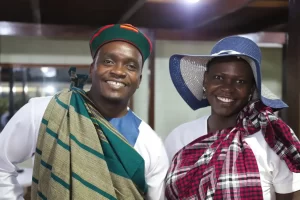I had the opportunity to visit Karamoja for the first time. This happened in mid-March 2024, when I travelled to Moroto for a one-week retreat with fellow communicators to deliberate on various issues relating to our work. While there, we were taken on guided tours, where we got the opportunity to appreciate the region while interacting with the natives.
At the climax of day one, we had a cultural experience with live traditional performances. We were all dressed up for the occasion in Karamojong attire and properly mingled with the cultural troupe. It was a thrilling experience for all of us. I witnessed, for the first time, the famous cultural dance that involves jumping so high and shaking the body. I learned that traditionally, the male who jumps highest qualifies against others to marry a bride who is ready to start a family. With this requirement, the tallest would likely have more favours compared to their “down-to-earth” counterparts, and I would perhaps be single and searching today!

On day four, our delegation, led by Col Emmy Katabazi, the Deputy Director General of ISO, paid a courtesy call to the Bishop of Karamoja Diocese, the Rt. Rev. Joseph Abura, at his residence in the heart of Moroto. We tapped into his lot of wisdom, where he stressed the need for affirmative action on compulsory free education in the region, right from the primary level to technical institutions for real-life skills.
In the Bishop’s conversation, you could clearly see his passion and dream to have a stable region where people live without worrying about tomorrow. He also hinted that the stable situation in the region was just seasonal, indicating that during such times, the warriors tend to minimise attacks because of the harsh climatic conditions. On behalf of ISO, Col Katabazi pledged support for the development programmes of the diocese.
We later had four visits to Moroto: the marble stone factory (Sunbelt), which deals in mining and processing marble stones; the Moroto-Lokitanya-Loroo Amudat road currently being upgraded to Tarmac; the Moroto Main Market; and an evening tour around the town to witness the nightlife.
According to Col Emmy Katabazi, research previously conducted indicates that Karamoja has over 50 mineral deposits with the capacity to mine marble stones in particular for up to 300 years before being exhausted. Marble stones are raw materials for various products, including tiles, furniture, toilet seats, utensils, and paint, among others.
Previously, Sunbelt exported marble stones to China as blocks until President Y.K. Museveni banned the exportation of raw materials a few years ago. The factory, located in Nanyidik village in Rupa Sub-County, Moroto district, was commissioned by the President of the Republic of Uganda in March 2020.
With the untapped mining opportunities in the region, Karamoja remains one of the most potentially rich areas in Africa. This has a direct impact on livelihoods for the native Karamajongs and Ugandans at large. Sunbelt alone constructed a 15-kilometre road and caused the extension of hydropower to Nanyidik village. This means better access to essential services such as education and health facilities.
We embarked on our journey to Kidepo on the fifth day through Kotido and Kaabong. The murram road connecting Moroto to Kidepo National Park was well maintained, along with grid electricity connections all the way. It took us a few hours to reach our destination without a single hindrance.
Along the way, we witnessed unique acacia trees with orange stems where gum Arabic is extracted, a natural secretion from hardened sap. This element is used in the production of various products, including beverages and pharmaceuticals. Once again, this is a Karamoja treasure—a rare species of tree you can hardly find anywhere else!
We safely reached Kidepo Valley National Park and settled at Katurum Lodge, a place with perfect scenery overlooking the park, where we had an evening game drive, chilling with a multitude of animals of various kinds amid the cool breeze. This was an experience everyone had looked forward to after a long week of deliberations and brainstorming.
In 2018, CNN ranked Kidepo Valley National Park as the second-most beautiful park in Africa. This is just another treasure in Karamoja, with quite a lot of potential.
This week-long activity and traverse of the Karamoja region gave me an experience unique to the perception and misconception I had before. My admiration for the culture and physical landscape of the region will dwell permanently in my heart. It will take our collective effort to develop Karamoja, and it starts with a visit and appreciation of the region.
By Robert Sharp Mugabe
The writer is the Assistant Director at the Government Citizen Interaction Centre